Chapter: Introduction to Botany: Tissues and organs; How the Plant is built
Morphology of the Leaf
Morphology of the Leaf
Morphology means external, well visible structural features whereas anatomy needs tools like a microscope
and/or scalpel. Leaves are very important in plant morphology. The ability to
describe the leaf is a must even for novices in botany.
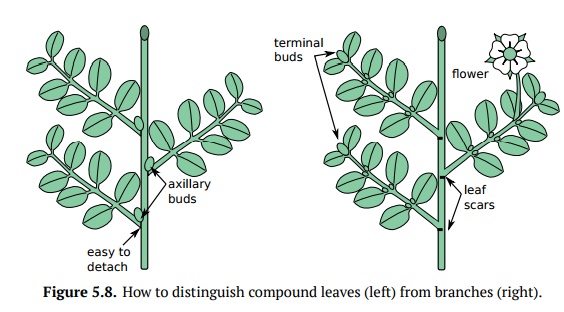
In all, plants are fractal organisms, like
Sierpinski triange (Fig. 5.9). All fractals are
self-similar (Fig. 5.10), and plants are no
exception. Self-similarity, or “Rus-sian doll effect” means that almost every
part of plant may be a part of the bigger complex, this bigger one—the part of
even bigger system, and so on. This is what we see in leaves as levels of hierarchy. Simple leaves have just one level of
hierar-chy whereas compound leaves have two or more levels of hierarchy. Compoundleaves are sometimes mixed with
branches but there are many other character-istics which allow to distinguish
them (Fig. 5.8).

To describe leaves,
one should always note the level of hierarchy like “on the first level of
hierarchy, the shape is ..., on the second level of hierarchy, the shape is
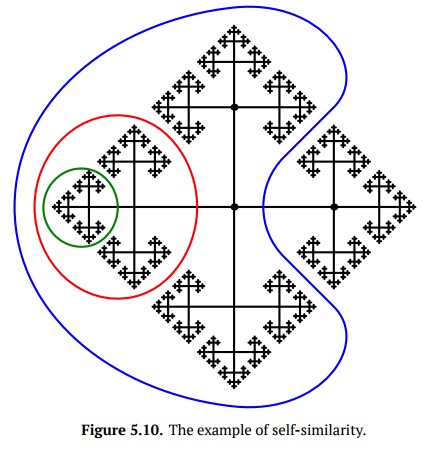
...” As it was
mentioned above, leaf hierarchy is similar to Russian dolls: every smaller doll
has a bigger doll (next hierarchy level) outside. For example, if the leaf is
compound (consists of multiple leaflets), the overall shape of it could be,
saying, round (circular) but the shape of individual leaflet of the very same
leaf could be ovate (Fig. 5.11). As a result,
the description will say that on first level of hierarchy the leaf is ovate,
and on the third level—circular.
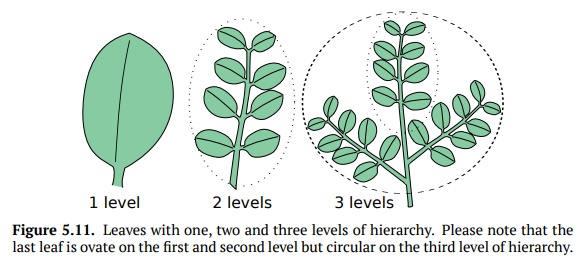
There are three types
of leaf characters: general, terminal, and repetitive. Gen-eral characters are only applicable to the whole leaf. Terminal characters areonly applicable
to the terminal leaflets. Lastly, repetitive characters repeat on each level of
leaf hierarchy. General and terminal characters do not depend on hierarchy. Repetitive characters may be different
on each step of hierarchy.
General characters of
leaf include stipules and other
structures located near leaf base (Fig. 5.12): sheath (typical for grasses and other
liliids) and ocrea (typical for
buckwheat family, Polygonaceae).
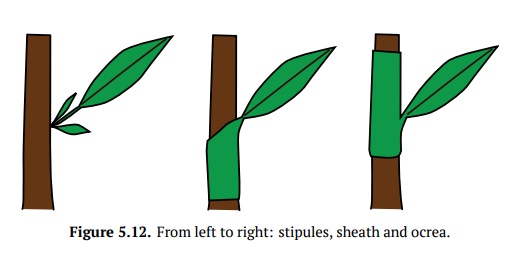
Repetitive characters
are the shape of the leaf (Fig. 5.13), leaf
dissection, and whether the blade is stalked (has petiole) or not.
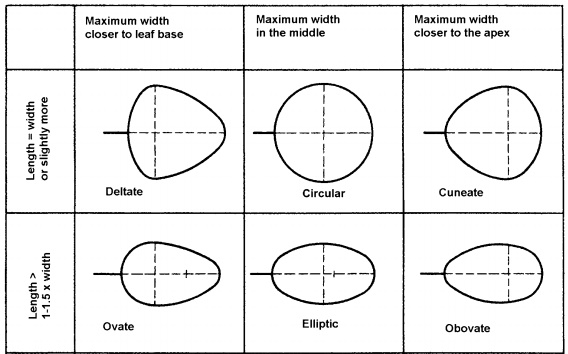
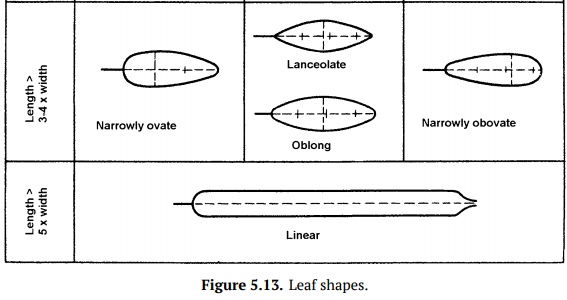
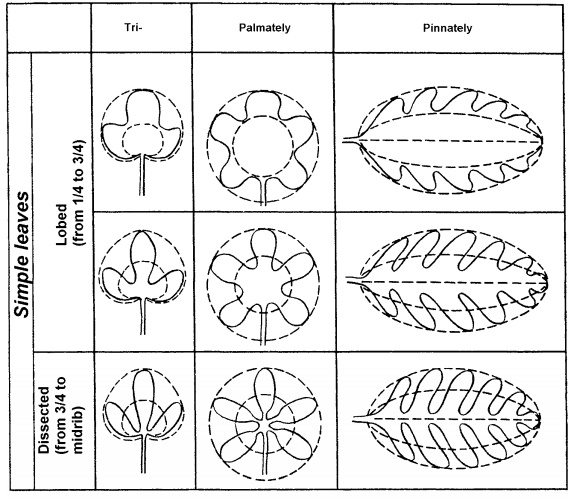

Terminal characters
are applicable only to terminal leaflets of leaves. These characters (Fig. 5.15) are the shape of the leaf blade base, the leaf
tip, the type of margin, the surface, and the venation. The base of the leaf
blade could be rounded, truncate (straight), cuneate, and cordate. The leaf apex could berounded, mucronate, acute, obtuse, and acuminate.
Leaf margin variants are entire (smooth)
and toothed: dentate, serrate, double serrate and crenate.
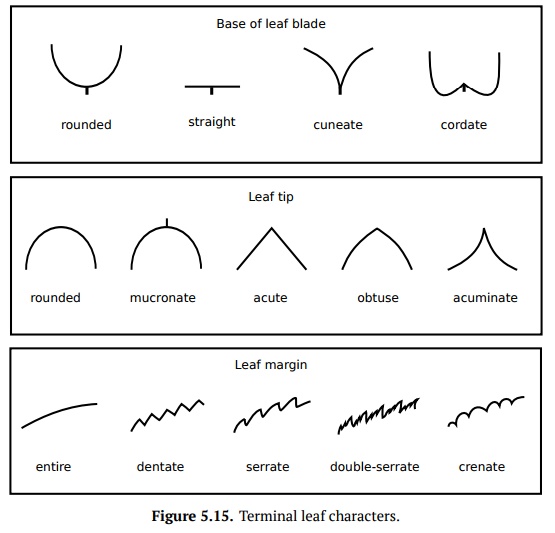
Leaf veins are
vascular bundles coming to the leaf from stem. Frequently, there is a main vein and lateral veins (veins of second order). There are multiple
classifications of leaf venation; and example is shown on the table below:
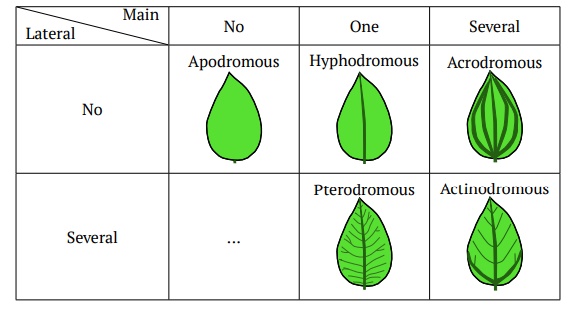
An important type of
venation which is absent from this table, is dichotomous. It is similar to acrodromous (there is no main vein
but many lateral) but more promitive. Each vein divides into two similar parts
which is known as dichoto-mous branching. The example of dichotomous venation
is the leaf of maidenhair tree, ginkgo (Ginkgo
biloba). Another frequently segregated type of venation is parallellodromous, in essence, this is
acrodromous venation in linear leaves(for example, leaves of grasses): most of
veins are almost parallel.
To characterize the
whole leaf, one might use the following plan:
1.
General characters (leaf as a whole):
(a)
stipules (present / absent, deciduous / not, how many, size, shape);
(b)
base (sheath / no sheath, ocrea / no ocrea)
2.
First level of hierarchy: repetitive characters:
(a)
symmetry (symmetrical / asymmetrical);
(b)
shape;
(c)
dissection;
(d)
petiole (presence and length)
3.
Second level of hierarchy
4.
Third level of hierarchy, and so on
5.
Terminal characters (leaflets):
(a)
base of leaf blade (rounded, truncate, cuneate, cordate);
(b)
apex (rounded, mucronate, acute, obtuse, acuminate);
(c)
margin (whole, dentate, serrate, double serrate, crenate );
(d)
surfaces (color, hairs etc.);
(e)
venation (apo-, hypho-, acro-, ptero-, actinodromous)
Heterophylly refers to a plant having more than one kind of leaf. A plant canhave
both juvenile leaves and adult leaves, water leaves and air leaves, or sun
leaves and shade leaves. A leaf mosaics refers to the distribution of leaves in
a single plane perpendicular to light rays, this provides the least amount of
shad-ing for each leaf.
Leaves have seasonal
lives; they arise from the SAM through leaf
primordia, and grow via marginal meristems. The old leaves separate from
the plant with an abscission zone.
The famous poet and
writer Johann Wolfgang Goethe is also considered a founder of plant morphology.
He is invented an idea of a “primordial plant” which he called “Urpflanze”
where all organs were modifications
of several primordial ones. In accordance to Goethe’s ideas, plant morphology
considers that many visible plant parts are just modifications of basic plant
organs.
Modifications of the
leaf include spines or scales for defense, tendrils for sup-port, traps, “sticky tapes”, or urns for interactions (in that case,
catching in-sects), plantlets for
expansion, and succulent leaves for
storage. Plantlets are little mini plants that grow on the main plant and then
fall off and grow into new plants; the most known example is Kalanchoë (“mother of thousands”) which
frequently uses plantlets to reproduce. Plants that have insect traps of
various kinds are called carnivorous plants (in fact, they are still
photoautotrophs and use insect bodied only as fertilizer). Several types of these
are the cobra lily (Dar-lingtonia),
various pitcher plants (Nepenthes, Cephalotus, Sarracenia), the butter-wort (Utricularia),
the sundew (Drosera), and the best
known, the Venus flytrap (Dionaea).
Related Topics